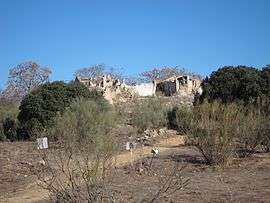Cortijo
A cortijo is a type of traditional rural habitat in the Southern half of Spain, including all of Andalusia and parts of Extremadura and Castile-La Mancha.[1]
Cortijos may have their origins in ancient Roman villas, for the word is derived from the Latin cohorticulum, a diminutive of cohors, meaning 'courtyard'.[2] They are often isolated structures associated with a large family farming or livestock operation in the vast and empty adjoining lands.[3]
Description

A cortijo would usually include a large house, together with accessory buildings such as workers' quarters, sheds to house livestock, granaries, oil mills, barns and often a wall enclosing a courtyard.[3] It was also common for isolated cortijos to include a small chapel.
In mountain areas, rough stone was often used for wall construction and ashlar for corners, doorways, windows and arches. In ancient cortijos, mud or slaked lime were used as mortar. However, the traditional materials were replaced by cement and brick construction in more recent ones. In places where stone was hard to come by, adobe was more common as a construction material. Usually cortijos were whitewashed. Roofs were built with wooden beam structures and covered with red ceramic roof tiles.[3]
The master of the cortijo or "señorito" would usually live with his family in a two story building when visiting, while the accessory structures were for the labourers and their families —also known as "cortijeros".[1] The latter buildings were usually of more simple construction.[4]
The cortijo as a habitat is surrounded by cultivated lands, such as olive trees or other kind of agricultural exploitation. In certain desolate areas of the southern Central Meseta, Extremadura and Sierra Morena, a cortijo would be the only inhabited center for many miles around. Thus, most of them were self-sufficient units, as far as that was possible.[3]
Many cortijos became deserted following General Franco's Plan de Estabilización and the abandonment of traditional agricultural practices by the local youth, including the lifestyle changes that swept over rural Spain during the second half of the 20th century.[5]
Famous cortijos

- Cortijo de Arroyovil, where Francisco Franco used to overnight when hunting the red-legged partridge, near to Mancha Real.[6]
- Cortijo de Miraflores, a historical building in Marbella.
- Cortijo Jurado, near Campanillas; reputed to be haunted.
- Cortijo de las Mezquitas
- Cortijo de Alventu
- Cortijo Bacardí
- Cortijo del Fraile, in Níjar municipality.
- Cortijo de Aparicio el Grande
- Cortijo Cañaveral de los Frailes
- Cortijo del Búho in Riópar, Albacete Province
- El Cortijo, a famous nightclub in Barcelona in former times
- Casa Zaldívar, a cortijo in Casas de Don Pedro that became a Francoist concentration camp where Spanish Republican military personnel were interned and where many were shot[7] at the time of the Spanish Civil War.[8]
- Cortijo del Enjembraero, located in Helechal, Benquerencia de la Serena municipality, where four political prisoners: Sinesio Calderón, Antonio Cortés, Antonio Iglesias and Manuel Merinot were executed extrajudiciallly on 1 February 1949 accused by the Francoist authorities of assisting the Spanish Maquis.[9][10]
See also
References
- 1 2 Antonio Alcalá Venceslada, Vocabulario Andaluz, El Mundo-Unidad Editorial, Barcelona 1999, p. 173
- ↑ Manuel-Antonio Marcos Casquero, Marcus Terentius Varro, De lingua Latina: edición bilingüe, Anthropos Editorial, 1990, ISBN 8476582382, pg. 69.
- 1 2 3 4 Antonio López Ontiveros et al. Geografía de Andalucía, Ed. Ariel, Barcelona 2003 ISBN 84-344-3476-8
- ↑ Gemma Florido Trujillo: Poblamiento y hábitat rural: Caracterización, evolución y situación actual, p. 337
- ↑ Xavier Tafunell, (2004). Historia económica de la España contemporánea. Crítica. ISBN 8484325024
- ↑ In Spanish: Visits to a part of the history
- ↑ Campo de Concentración de Casa Zaldívar: fusilamientos del 15 de mayo de 1939
- ↑ Fernando Barrero Arzac, Historia y tragedia de la 109ª BM en el campo de Zaldívar (Badajoz)
- ↑ Secundino Serrano Fernández, (2011). Maquis. Historia de la guerrilla antifranquista. Madrid: Temas de hoy. p. 242. ISBN 84-8460-103-X.
- ↑ Justo Vila Izquierdo, Santiago Álvarez, José Hinojosa & José Sandoval (2003). La guerrilla antifranquista en Extremadura. El movimiento guerrillero de los años 40. Barcelona: Universitas. p. 105. ISBN 84-87098-39-8
External links
 Media related to Cortijos at Wikimedia Commons
Media related to Cortijos at Wikimedia Commons- Cortijos, haciendas y lagares de Andalucía. Instituto Andaluz del Patrimonio Histórico